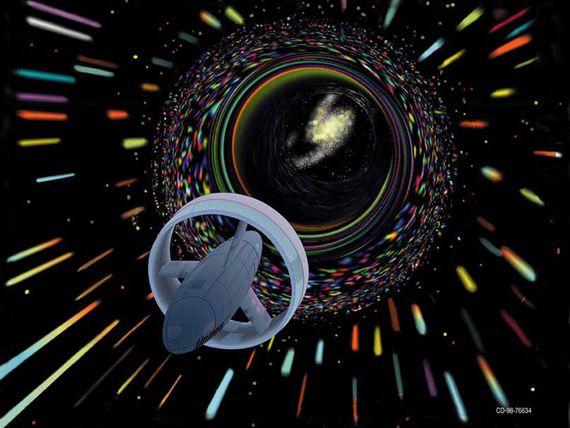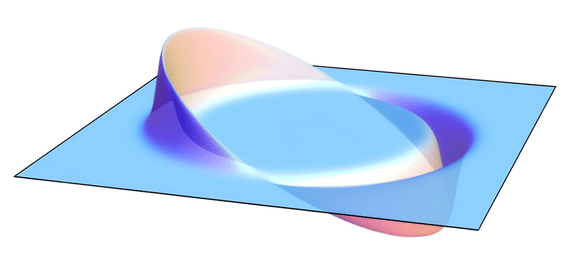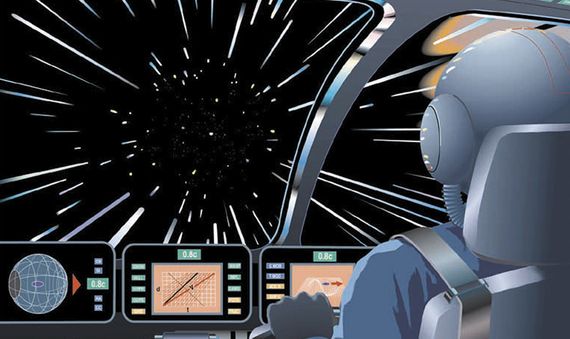Traveling faster than light is an inevitable longing for the human species, which aspires to expand through the cosmos. But in reality, if we think about it, light moves very slowly compared to the immense scales of the universe: Earthlings would have to wait more than four years for a ship travelling at the speed of light to reach the closest stars, and 25,000 years to get to the nearest galaxy, Canis Major Dwarf. It would seem that we are condemned to never meet other beings with whom we might establish a civilized relationship.
Fortunately, modern theoretical physics offers us a solution: manipulate space-time to move ourselves to other remote places in the cosmos without formally violating the universal speed limit. The simplest explanation to take home of why you can’t travel faster than light is this: if it were done, an effect could appear before its cause, since the velocity of light is the invariant cosmic ruler that measures physical phenomena—we could receive a phone call before the caller thinks about making it.

However, since Einstein’s general relativity defined space-time as the fabric from which the universe is made, the theory does allow this cosmic tapestry to wrinkle; an example is the gravitational waves detected in recent years by the LIGO and Virgo experiments. If we could create wrinkles in space-time, we might be able to manage to bring a distant location much closer to us, so it would be possible to reach it without breaking the light speed barrier.
Alcubierre’s model
A device capable of achieving this is known as a warp drive and was proposed in 1994 by the Mexican theoretical physicist Miguel Alcubierre, inspired by the concept and the name given in the television series Star Trek, as confirmed by the physicist to OpenMind in a prior interview. The idea is to “create a bubble of distorted space inside which would be the spacecraft,” said Alcubierre, so that “the space behind the object that we want to move would violently expand, and at the same time the space in front of the object would contract.” Thus, “the object moves without actually moving; it is space itself that does the work.”
Alcubierre’s model, considered one of the most formally correct to propose an interstellar voyage on paper, has motivated countless studies and not a little speculation. Recently, a report has been published that the US Department of Defense assigned to two physicists in 2010, entitled Warp Drive, Dark Energy and the Manipulation of Extra Dimensions. The authors present “two loopholes to Einstein’s ultimate speed limit”: the warp drive and wormholes—technically called Einstein-Rosen bridges—a kind of shortcut in the fabric of space-time that would connect very distant regions of the universe, and whose existence is theoretically possible.

The report focuses on Alcubierre’s model, and above all on exploring how the necessary curvature bubble could be created. As the astrophysicist Geraint Lewis from the University of Sydney (Australia), who did not participate in the report, explained to OpenMind: “We know that normal matter can curve space-time, but matter cannot bend space the right way to make a warp drive.” Lewis clarifies that this requires: “very non-normal matter that contains a tension, rather than a pressure that you would have with a gas.” In other words, we need a type of matter capable of generating negative pressure, or negative energy. And this description fits precisely with something that Lewis is an expert in: dark energy. “There is the potential for dark energy to give us a warp drive,” he suggests.
A 193-second journey to Mars
According to current cosmological models, dark energy is what makes up more than 70% of the entire universe. It’s a hypothetical type of antigravity that is responsible for the accelerated expansion of the universe. The authors of the report propose using this dark energy to open a bubble in an additional dimension, which could fit a ship of about 100 cubic metres, somewhat larger than a standard truck. “Trips to the planets within our own solar system would take hours rather than years, and journeys to local star system would be measured in weeks rather than hundreds of thousands of years,” they write. As examples, the authors calculate that at a speed 100 times greater than that of light, Mars would only be a 193-second journey; Jupiter could be reached 36 minutes, Alpha Centauri in 15 days and the Orion nebula in 1.3 years.
All this sounds enormously tempting, but is there any chance that these proposals could go from paper to reality? Is it just a matter of advanced engineering, or are we facing some insurmountable physical barrier? There is a widespread belief among physicists that these ideas will never materialize. Alcubierre himself points out some colossal obstacles, such as the so-called “horizon problem”: “when traveling faster than light, the front of the bubble is not accessible from the inside, so the ship that is in the centre cannot place the energy at that spot.” “Systems like the one I proposed are almost impossible, but it’s difficult to know,” he concludes.

Naturally, the main obstacle is the energy requirement: the proposal of the authors of the report significantly reduces the amount of energy needed, but even so, travelling at 100 times the speed of light would require an energy input of the order of one tenth of the total power of the Sun. “The energies are still far in excess of those available in the foreseeable future,” the authors admit.
More critical is another essential aspect: this immense quantity of energy will have to be provided not in the form of the energy we handle on a daily basis, but as something called negative energy, which does not yet even exist. “At the moment, we have no idea if we can obtain such a material in any physically workable way, so that a warp drive might be theoretically possible, but practically impossible,” warns Lewis.
All of which has not prevented us from already trying. At NASA’s Johnson Centre there is an Advanced Propulsion Physics Laboratory—informally called Eagleworks Laboratory—which the agency itself does not tend to promote too much, but which has been trying to create microscopic curvature bubbles for years as a proof of concept. At the moment it is still science fiction, but Lewis is optimistic: “As we push the theories of gravity and quantum mechanics together, hopefully we will find clues to make this a reality, which is what I hope will happen.”
Comments on this publication